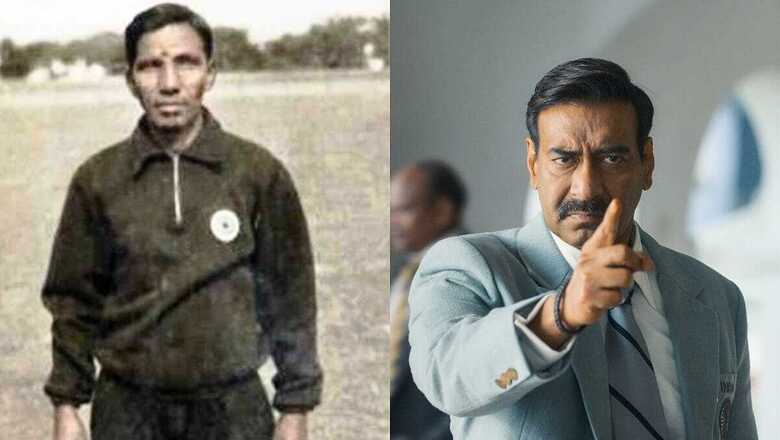
views
There’s a lot to be said about Indian Football and the state of it today. Good, bad, ugly, and everything in between. But, what is undeniable is the rich history of football that has always existed in this nation. One of the biggest yet underappreciated names of Indian Football is none other than that of Syed Abdul Rahim.
Well, it seems as if the legendary coach is set to receive his much-deserved flowers now, with the release of ‘Maidaan’, Boney Kapoor’s anticipated release, starring Ajay Devgn.
This EID, get ready to celebrate an inspiring legacy of #SyedAbdulRahim.It’s time to honor his untold & remarkable journey of courage, patriotism, and dedication. ⚽️#Maidaan in cinemas 10th April!Reserve your seats now!– https://t.co/fRjCbJydkw#MaidaanInIMAX… pic.twitter.com/m5BHYJQS47
— Ajay Devgn (@ajaydevgn) April 8, 2024
But, for those who still want to understand more about the legend Rahim, let us walk down memory lane to gather an understanding of the icon of Indian Football.
Stay updated with the latest from IPL 2024, including top contenders for the IPL 2024 Orange Cap and IPL 2024 Purple Cap. Explore the complete IPL 2024 Schedule, IPL 2024 Points Table and players with the Most Sixes, Most Fours and Most Fifties in IPL 2024
Who Is Syed Abdul Rahim?
Syed Abdul Rahim, affectionately referred to as Rahim saab, was born on the 17th of August, 1909 in Hyderabad. He would grow up to represent the football teams of multiple colleges and become a teacher initially at several institutions such as Kachiguda Middle School, Urdu Sharif School, Darul-ul-Uloom High School and Chaderghat High School.
Rahim’s introduction to coaching came in 1943 when he took the helm at the Hyderabad Football Association, a position he would hold onto till his death. In 1950 he became the coach of the Hyderabad Police. Under his guidance, the team triumphed in the Rovers Cup five times in a row and lifted the Durand Cup four times.
But, his and Indian football’s highest point would arrive in the 13 years spent training the Indian Football Team from 1950 onwards, now regarded as the ‘Golden Age of Indian Football’.
Syed Abdul Rahim: Architect of Indian Football
Considered as the architect of the Indian football, Rahim was the manager of the Indian Football from 1950-1963. It was under his supervision and his then-advanced strategies that the Indian football team qualified into the semi-finals of 1956 Melbourne Olympics football, becoming the first Asian team to reach that esteemed milestone.
After refusing to participate in the 1950 FIFA World Cup, India won gold at the 1951 Asian Games, beating a strong Iranian side 1-0 in front of a packed home crowd in Delhi, with Prime Minister Jawaharlal Nehru in attendance.
And this journey to the top of the Asian footballing world was made possible due to the foresight and vision of Rahim saab, whose emphasis on resorting to a ‘one-touch’ style of football coupled with a focus on training the weaker foot in order help his players achieve an ambidextrous nature of play, skyrocketed India to the peak of Asian Football.
But, his biggest moment of genius arrived when the revolutionary coach opted for the 4-2-4 system, a formation that was made popular much later by the Brazilians in the 1958 and 1962 World Cup, in an era that was dominated by a 2-3-5 style of play.
Rahim saab’s contributions to Indian Football did not stop with his retirement from the game. His intent and passion to develop and nurture players and players who could become even better coaches to help carry Indian Football forward, was a defining trait of his.
“First of all, we should produce or train the producers or coaches,” Rahim was quoted saying in a 1955 interview to Indian Express.
Syed Abdul Rahim’s interview given to Indian Express in 1955. Notice how many of his views are relevant even today #IndianFootball pic.twitter.com/5QDCDpnOud— IndianFootball_History (@IndianfootballH) October 20, 2019
“Any short-term scheme for training of present footballers or any scheme to send footballers to foreign countries for training will do permanent good to the game,” he added.
His dream for the AIFF to develop a network of coaches to help scout and develop talent across the nation, continues to remain a dream for the most part, as the commercialization of Indian Football, and the monopoly that exists in the capitalization of the sport continues to hinder the growth that football as a whole may witness with time in out country.
But, nonetheless, for those who may or may not be aware of the rich history of Indian Football, Maidaan promises to provide a little glimpse into the same, as the legacy of Rahim saab shall be celebrated for once.



















Comments
0 comment